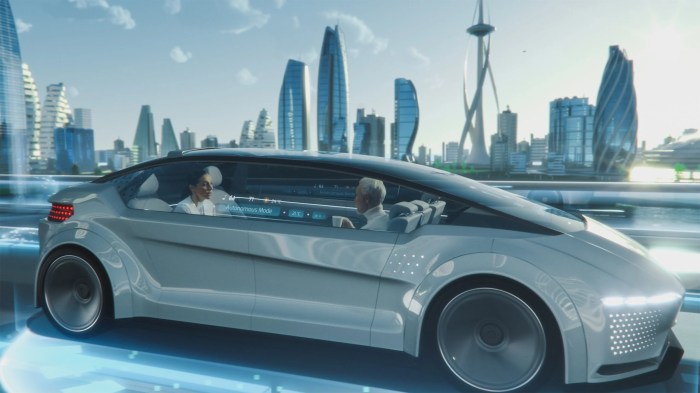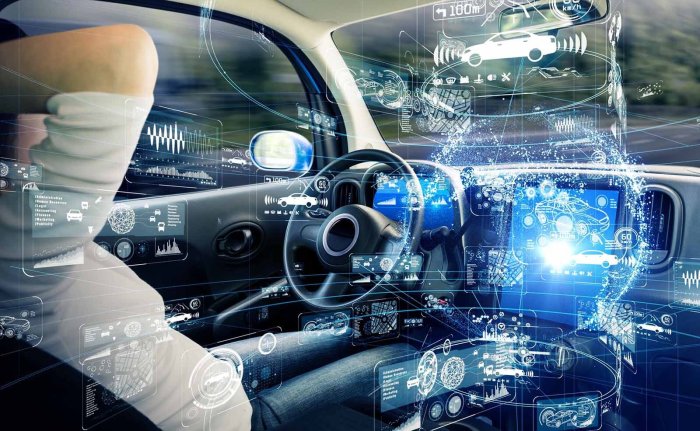Kicking off with The future of autonomous vehicles in the automotive industry, this opening paragraph is designed to captivate and engage the readers, setting the tone informal but serious style that unfolds with each word.
Autonomous vehicles are revolutionizing the automotive industry, paving the way for safer, more efficient transportation. From the history of autonomous vehicles to the technological challenges they face, the future is promising but not without its hurdles.
Overview of Autonomous Vehicles

Autonomous vehicles, also known as self-driving cars, have been a topic of interest and innovation in the automotive industry for several years. These vehicles are equipped with advanced technology and sensors that enable them to navigate and operate without human intervention.
In the early stages, autonomous vehicle technology was primarily focused on research and development by leading tech companies. However, in recent years, traditional automakers have also entered the race to develop autonomous vehicles, recognizing the potential benefits and market demand.
Brief History of Autonomous Vehicles
Autonomous vehicle technology has evolved significantly over the years. The concept of self-driving cars dates back to the 1920s, with various experiments and prototypes showcasing the potential for automated driving. In the 21st century, advancements in artificial intelligence, machine learning, and sensor technology have accelerated the development of autonomous vehicles.
Current State of Autonomous Vehicle Technology
Currently, autonomous vehicle technology is at a stage where semi-autonomous features are becoming more common in modern vehicles. Features such as adaptive cruise control, lane-keeping assist, and automatic emergency braking are examples of technologies that contribute to the overall goal of achieving fully autonomous driving.
Levels of Autonomy in Vehicles
- Level 0: No Automation – The driver is in full control of the vehicle at all times.
- Level 1: Driver Assistance – The vehicle can assist with certain functions, such as steering or acceleration, but the driver remains in control.
- Level 2: Partial Automation – The vehicle can control both steering and acceleration/deceleration under certain conditions, but the driver must remain engaged and monitor the environment.
- Level 3: Conditional Automation – The vehicle can manage most aspects of driving in certain conditions, but the driver must be ready to take over when prompted.
- Level 4: High Automation – The vehicle can operate autonomously in most conditions, with the driver only required to intervene in exceptional circumstances.
- Level 5: Full Automation – The vehicle is capable of complete autonomy in all conditions, with no human intervention necessary.
Benefits of Autonomous Vehicles: The Future Of Autonomous Vehicles In The Automotive Industry

Autonomous vehicles offer a multitude of benefits that can revolutionize the way we commute and travel. From increased safety to enhanced mobility options, these vehicles are set to transform the automotive industry in numerous ways.
Improved Safety
Autonomous vehicles are equipped with advanced sensors and technology that can significantly reduce the number of accidents on the road. With features like automatic emergency braking and lane-keeping assistance, these vehicles can detect potential dangers and react much faster than human drivers. Studies have shown that autonomous vehicles have the potential to prevent up to 90% of accidents caused by human error, making our roads safer for everyone.
Traffic Flow and Congestion
One of the major advantages of autonomous vehicles is their ability to communicate with each other and coordinate movements seamlessly. This can lead to smoother traffic flow, reduced congestion, and ultimately shorter commute times for all drivers. By optimizing speed and spacing between vehicles, autonomous vehicles can help alleviate the gridlock that plagues many urban areas.
Enhanced Mobility for the Elderly and Disabled
Autonomous vehicles have the potential to greatly improve mobility options for the elderly and disabled populations. These individuals often face challenges when it comes to driving or accessing public transportation. With autonomous vehicles, they can enjoy greater independence and freedom to travel to various destinations without relying on others for assistance. This increased mobility can lead to improved quality of life and greater opportunities for social engagement.
Technological Challenges
Autonomous vehicles face several technological challenges that need to be addressed for their successful integration into the automotive industry. These challenges range from sensor limitations to cybersecurity concerns and the crucial role of artificial intelligence and machine learning in autonomous driving.
Sensor Limitations
Sensors play a vital role in enabling autonomous vehicles to perceive and understand their environment. However, these sensors can face limitations in certain conditions, such as inclement weather or poor lighting. This can affect the vehicle’s ability to make accurate decisions and navigate safely.
Role of Artificial Intelligence and Machine Learning
Artificial intelligence and machine learning are essential components of autonomous driving technology. These technologies enable vehicles to learn from data, make real-time decisions, and improve their performance over time. However, developing advanced AI algorithms that can accurately interpret complex driving scenarios remains a significant challenge.
Cybersecurity Concerns
The increasing connectivity of autonomous vehicles raises concerns about cybersecurity threats. Hackers could potentially gain unauthorized access to vehicle systems, compromising safety and privacy. Ensuring robust cybersecurity measures is crucial to prevent cyber-attacks and safeguard the integrity of autonomous vehicles on the road.
Impact on the Automotive Industry
Autonomous vehicles are revolutionizing the automotive industry, leading to significant changes in traditional business models, job opportunities, and manufacturing processes.
Reshaping Business Models
Autonomous vehicles are reshaping traditional business models in the automotive industry by shifting the focus from individual car ownership to shared mobility services. Companies are exploring new revenue streams through ride-hailing services, autonomous delivery vehicles, and mobility-as-a-service platforms. This shift is challenging automakers to adapt their strategies and offerings to meet the changing demands of consumers in a digitally connected world.
Job Displacement and Creation
The rise of autonomous vehicles has the potential to displace certain roles within the automotive industry, such as drivers and mechanics, as automation takes over certain tasks. However, it also creates new job opportunities in areas like software development, data analysis, cybersecurity, and vehicle maintenance for autonomous systems. Companies are investing in upskilling and reskilling programs to prepare their workforce for the transition to an autonomous future.
Influence on Car Design and Manufacturing, The future of autonomous vehicles in the automotive industry
Autonomous vehicles are influencing car design and manufacturing processes by prioritizing safety, efficiency, and user experience. Vehicle interiors are being reimagined to accommodate new technologies like sensors, cameras, and connectivity features. Manufacturing processes are becoming more automated and streamlined to meet the demands of producing complex autonomous systems. Automakers are collaborating with tech companies to integrate cutting-edge technologies into their vehicles, driving innovation in design and production.
Regulations and Legal Implications
Autonomous vehicles are a groundbreaking technology that is reshaping the automotive industry. However, along with the technological advancements, there are several legal and regulatory aspects that need to be addressed to ensure the safe and ethical implementation of autonomous vehicles on the roads.
Current Regulations
In the United States, the National Highway Traffic Safety Administration (NHTSA) has issued Federal Motor Vehicle Safety Standards (FMVSS) that govern the safety requirements for autonomous vehicles. Additionally, individual states have started implementing their own regulations regarding autonomous vehicle testing and deployment. Countries like Germany, Japan, and the UK have also established regulatory frameworks to oversee the development and operation of autonomous vehicles.
Ethical Considerations
One of the key ethical considerations surrounding autonomous vehicles is the decision-making algorithms. These algorithms are responsible for making split-second decisions in situations where accidents are unavoidable. The ethical dilemma arises when these algorithms have to prioritize between the safety of the occupants of the vehicle and that of pedestrians or other vehicles on the road. Balancing these priorities while adhering to ethical principles is a significant challenge that regulators and developers need to address.
Liability and Insurance Challenges
Another major legal implication of autonomous vehicles is the issue of liability and insurance. In traditional vehicles, the driver is usually held responsible for any accidents or violations. However, in the case of autonomous vehicles, where the vehicle itself is in control, determining liability becomes complex. Should it be the manufacturer, the software developer, the owner, or a combination of these parties? This question remains unanswered and poses a challenge for the legal system and insurance industry to adapt to the new paradigm of autonomous driving.
Last Word

As we look ahead, the future of autonomous vehicles in the automotive industry holds great promise. With advancements in technology, regulations, and societal acceptance, these vehicles are poised to transform the way we move from point A to point B. Buckle up for an exciting ride into the future of transportation!
When it comes to choosing the best car for your needs, there are a few key factors to consider. From size and style to fuel efficiency and safety features, it’s important to do your research. You can check out this helpful guide on How to choose the best car for your needs for more tips and insights.
Looking for the most fuel efficient cars of 2021? It’s essential to find a vehicle that not only fits your lifestyle but also saves you money at the pump. Check out this list of the Most fuel efficient cars 2021 to help you make an informed decision.